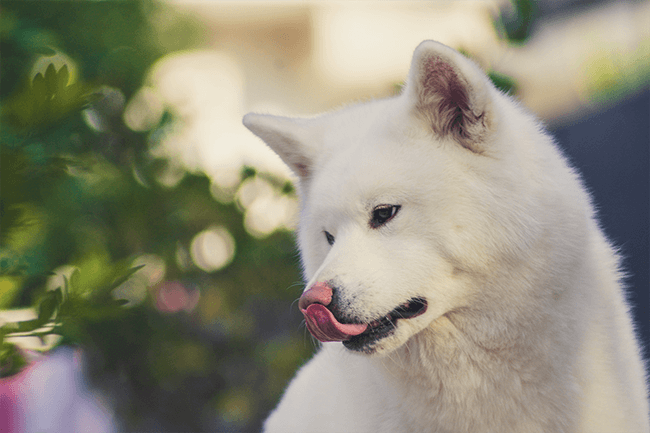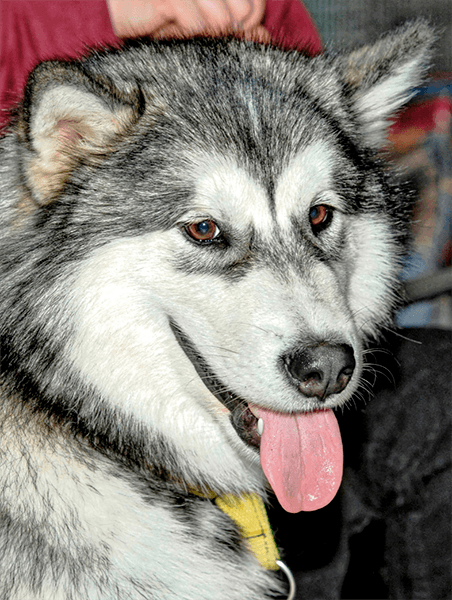The combination of two ancient breeds, the Siberian Huskey and Akita Inu, has created the Huskita. These hybrid Russian and Japanese dogs are intelligent, loyal companions for people with very active lifestyles.
Huskitas possess the best qualities of Huskies and Akitas. These large, friendly, athletic dogs reach 50-75 pounds and stand about 20-25 inches at their shoulder. They have brown eyes, black noses, and dense, medium-length fur in a variety of colors.
Huskitas are alert, loyal and affectionate.
If you are considering getting a Huskita, you have come to the right place. This is the ultimate guide to the Huskita breed. Learn about their characteristics, personality and behavior, and what type of lifestyle they are best suited to.
A warning in advance: Huskitas are large, high-energy dogs that require dedicated time and effort from their human companions!
What Is A Huskita?

Huskitas are large, muscular dogs that are slightly longer in stature than they are tall. Reaching anywhere from 50 to 75 pounds and ranging in height from 22 to 25 inches at the shoulder, the size of this breed is quite variable.
Their sweet faces carry a friendly, intelligent expression, and there is curiosity in their brown eyes and brows. Their triangular ears sit straight-up high on their head, making them look alert.
Huskitas have a wide variety of fur colors – white, gray, brown, black, red, agouti, fawn, sable, and silver. Some are solid colors, while others are multicolored with pinto and mask markings.
Their fur is straight in texture and medium in length. Huskitas have a super-dense double coat to insulate them from cold temperatures. Their undercoat sheds during spring and summer. This is not a suitable dog for people with allergies!
They are well adapted to an active outdoor lifestyle. With powerful legs and thickly padded paws, these dogs are built to run and pull in rugged terrain.
Behavior and Personality Traits
Huskitas are loving and playful family dogs. They are good with children and are alert and highly sensitive to their surroundings. They are loyal and protective of their people, submitting to their owners.
Because of their sensitive nature, they do not cope well with a lot of change. This breed prefers having a consistent daily schedule that keeps them busy. They are friendly and comfortable in a secure, familiar environment.
Huskitas parent breeds are both working dog breeds, so they are high energy and require a lot of physical and mental exertion to keep them out of mischief.
Huskitas thrive in suburban and rural homes where they have lots of space to run around. They do have a tendency for wanderlust, so ensure that you have a securely fenced-in yard before getting a Huskita.
Like all dogs, Huskitas benefit from early socialization. They can be quite wary of people and other animals they do not know. Owners should encourage friendliness to strangers from a young age.
Huskitas need rigorous and disciplined training from a young age that uses positive reinforcement. They are strong-willed dogs that get be hyperactive without proper training and exercise.
The Origin of the Huskita
Huskitas are also sometimes called Siberian Akitas. They are the result of crossing the Siberian Huskeyfrom Russia with the Akita Inu from Japan. Both of these are ancient breeds of working dogs.
Huskies are an over 3000-year-old breed that developed in Japan. They were bred as hunting and sled dogs in the Arctic. Akitas were developed as a hunting breed, and they were used as guard dogs by the Japanese royal family.
The two breeds were first intentionally crossed in the 1990s in North America to create the Huskita. The American Kennel Club does not recognize the Huskita as an official breed. The breed standard has not stabilized enough yet.
Activity Requirements for Huskitas

Huskitas are high energy dogs that require at least 90 minutes of vigorous exercise per day. They are the perfect companion for you if you go on daily hikes or trail runs. They thrive when given opportunities to put their intelligence to work.
If they are understimulated and do not get enough exercise, they are prone to howling, digging, and chewing on things they should not. Huskitas do not cope with being left home alone during the day while you are at work.
Grooming Requirements
Because of their thick double coat, Huskitas require weekly grooming, especially during the warmer months when they molt their undercoat. They do not require frequent bathing or having their coat clipped or trimmed.
When you get a Huskita, invest in a pin brush, comb, and nail clippers. Their claws grow relatively quickly and need a trim once or twice a month. Clean their ears regularly, as their thick ear fur traps debris.
Huskita Health Issues
Huskitas can be susceptible to epilepsy, hip dysplasia, and blood diseases. Generally, they have a 10–13 year life span.
Like with any dog, take them to the vet on a regular basis so that you can address any health issues as early as possible. Ensure your dog is up to date with all its shots.
Because they are energetic, highly food-oriented dogs, they can easily gain weight and develop health issues due to obesity. Ask your vet how to keep your Huskitas weight on track and what the best diet is for your Huskita.
Pros and Cons of the Huskita
The following table summarizes the positive and negative traits of Huskitas:
| Pros | Cons |
| Very affectionate and loyal | High potential for wanderlust |
| High energy and athletic | Can be loud and vocal |
| Alert and protective of its family | Cannot be left alone for extended periods |
| Intelligent working dogs | Require frequent grooming – shed a lot |
| Adapted to cold climates | Prone to weight gain |
Price of Huskita Puppies
Huskita puppy breeders charge a premium price, especially if the parents are purebred, pedigree Huskies and Akitas. Puppies are available for between $1000 and $3000. It is critical to do your homework and research breeders properly. There are many unscrupulous, illegitimate puppy breeders out there.
Animal rescue centers and breed-specific shelters for Akitas and Huskies often have Huskitas looking for forever homes. It is always better to adopt rather than shop!
Sadly, there are many of these playful, loyal dogs available at shelters for adoption.
Final Thoughts on the Huskita Mix
In a nutshell – Huskitas are athletic, energetic, and affectionate.
A hybrid of the Siberian Huskey and the Akita Inu, Huskitas retained many working dog characteristics from its parent breeds. They make fantastic companion animals and service dogs and have been used in police work.
These large dogs are ideal for families who live an active lifestyle in suburban or rural areas. They require dedication and time to train and need at least 90 minutes of daily exercise. Their thick double coat needs weekly grooming, as they shed seasonally.
Do you already own a Huskita?
Let us know your thoughts and experiences below!
